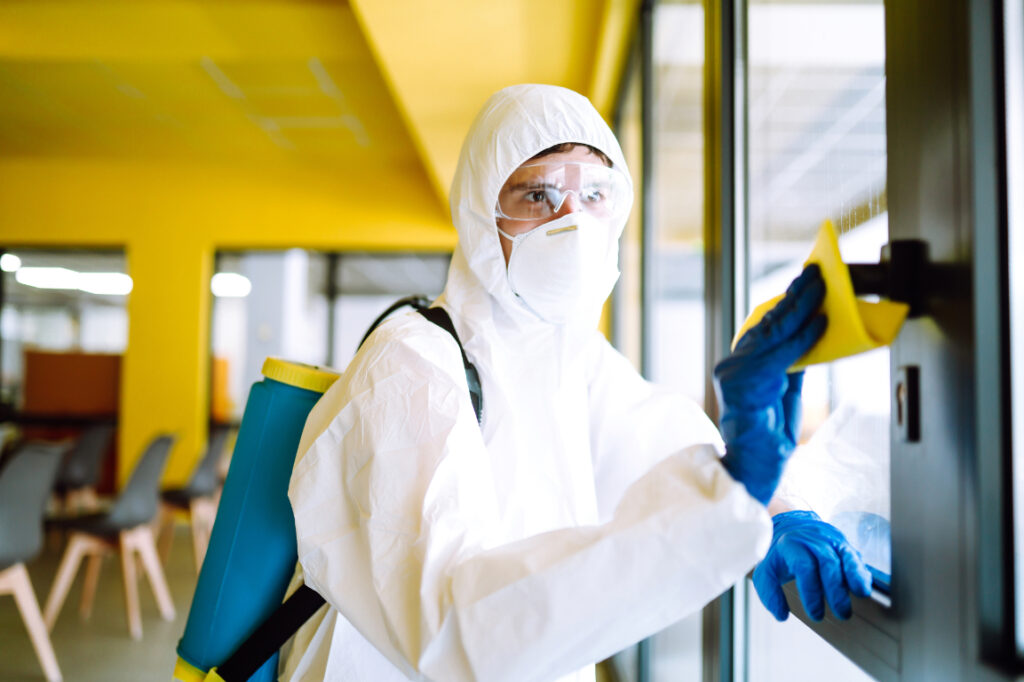
The cleaning industry gives high priority to safety for the well-being of cleaning professionals and a healthy work environment. Knowledge and adherence to safety protocols reduce accidents and enhance productivity. To achieve this, cleaning professionals must take essential safety courses to gain necessary skills and knowledge.
1. WHMIS (Workplace Hazardous Materials Information System):
WHMIS is a comprehensive system for providing information on the safe use of hazardous products used in Canadian workplaces. It ensures that workers receive consistent and comprehensive information about hazardous products.
Key Topics Covered:
- Hazard Classification: – Understanding the different classes of hazards.
- Labels: – Recognizing and understanding WHMIS labels.
- Safety Data Sheets (SDS): – Accessing and using SDS for hazardous products.
- Worker Education and Training: – Ensuring workers know how to handle hazardous materials safely.
2. PPE (Personal Protective Equipment) Training:
PPE training is critical for ensuring that cleaning professionals know how to use personal protective equipment correctly to protect themselves from potential hazards.
Key Topics Covered:
- Types of PPE: – Understanding different types of PPE (gloves, masks, eye protection, etc.).
- Proper Usage: -How to properly wear and maintain PPE.
- Limitations of PPE: – Understanding the limitations and proper disposal of PPE.
3. Ladder Safety:
Many cleaning tasks require the use of ladders, making ladder safety training essential to prevent falls and related injuries.
Key Topics Covered:
- Choosing the Right Ladder: – Selecting the appropriate ladder for the task.
- Inspection: – Inspecting ladders for defects before use.
- Proper Usage: – Safe practices for setting up and using ladders.
- Fall Protection: – Using fall protection equipment when necessary.
4. Chemical Safety:
Handling cleaning chemicals requires knowledge of their potential hazards and safe handling procedures.
Key Topics Covered:
- Chemical Labels and SDS: – Understanding labels and safety data sheets.
- Storage and Disposal: – Proper storage and disposal of chemicals.
- Emergency Procedures: – Procedures for dealing with chemical spills and exposures.
- Safe Handling Practices: – Using chemicals safely to prevent harm.
5. Ergonomics:
Ergonomics training helps cleaning professionals perform their tasks in ways that minimize strain and injury.
Key Topics Covered:
- Proper Lifting Techniques: – Techniques for lifting and carrying heavy objects safely.
- Posture and Movement: – Maintaining good posture and efficient movement to prevent injuries.
- Workstation Setup: – Setting up workstations to reduce strain.
6. Fire Safety:
Fire safety training is essential for preventing and responding to fire emergencies.
Key Topics Covered:
- Fire Prevention: – Identifying and mitigating fire hazards.
- Fire Extinguishers: – Proper use of fire extinguishers.
- Emergency Evacuation: – Procedures for evacuating in case of a fire.
- Emergency Response: – Responding to fire emergencies effectively.
7. Electrical Safety:
Electrical safety training is crucial for preventing electrical accidents and injuries.
Key Topics Covered:
- Electrical Hazards: – Identifying potential electrical hazards.
- Safe Practices: – Safe practices for working with electrical equipment.
- Lockout/Tagout: – Procedures for de-energizing and locking out equipment before maintenance.
- Emergency Response: – Responding to electrical emergencies.
8. First Aid and CPR:
First aid and CPR training can save lives in emergencies and is a valuable skill for all cleaning professionals.
Key Topics Covered:
- Basic First Aid: – Techniques for treating common injuries and illnesses.
- CPR: – Performing CPR on adults, children, and infants.
- Automated External Defibrillator (AED): – Using an AED in cardiac emergencies.
- Emergency Response: – Coordinating with emergency services and responding to emergencies.
Conclusion:
Investing in these safety courses can significantly benefit cleaning professionals by enhancing their skills and ensuring a safer work environment. Employers should prioritize these training courses to create a culture of safety and responsibility within their teams.

